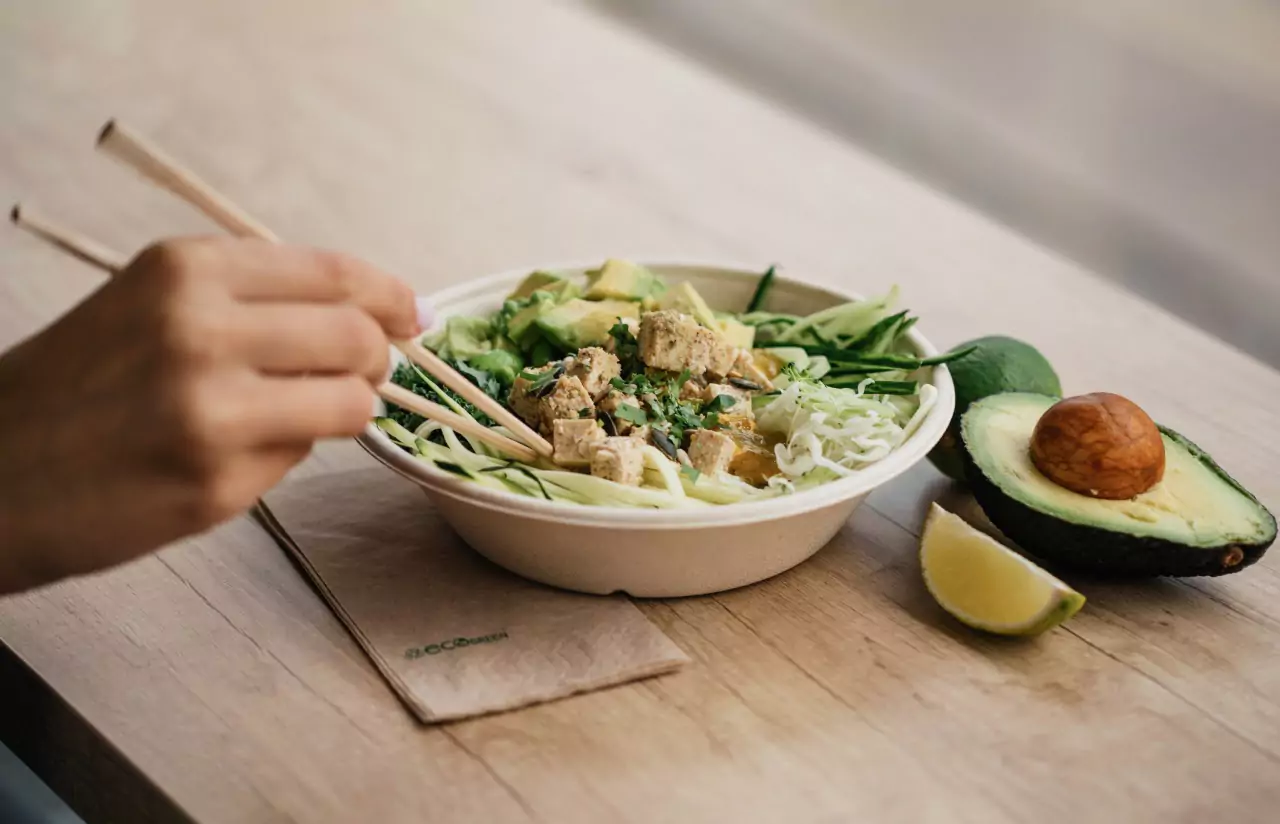Protein and Glucose—How Protein Affects Glucose

Key Takeways
- Protein helps steady glucose and energy when paired with carbs.
- Small swaps (like adding protein at breakfast) can curb crashes and cravings.
- Both plant and animal proteins can work; quality and timing matter most.
- Tracking meals and glucose helps you see what balance looks like for you.
- A glucose-expert like a registered dietitian can help you find your ideal protein intake.
- Protein helps steady glucose and energy when paired with carbs.
- Small swaps (like adding protein at breakfast) can curb crashes and cravings.
- Both plant and animal proteins can work; quality and timing matter most.
- Tracking meals and glucose helps you see what balance looks like for you.
- A glucose-expert like a registered dietitian can help you find your ideal protein intake.
The way you balance protein, carbs, and fat (the three macronutrients your body needs) can change how your body handles glucose. Carbs have the biggest impact on glucose, while fat and protein play quieter supporting roles.
Protein helps steady how glucose enters your system. Even though all macros fuel your body, they don’t all affect glucose the same way.
Gluconeogenesis basics
When you eat protein, your body breaks it down into amino acids: tiny building blocks it can use for repair or energy
Amino acids are used in a process called gluconeogenesis, which produces glucose from non-carbohydrate sources. This process kicks in when you go long stretches without eating, like overnight while you sleep.
In other words, amino acids have a minimal impact on glucose levels in healthy people. So while protein plays a role, it doesn’t spike glucose the way carbs do.
How does protein stabilize glucose levels

Protein might not spike glucose, but it helps keep things steady. When you eat carbohydrate-heavy meals or snacks, your glucose will rise as those carbs are broken down into glucose. Pairing carbs with protein smooths out the spikes and keeps your energy steady longer.
That familiar 3 p.m. slump
You pack a big salad for lunch, thinking it’s the perfect healthy choice. Yet by three p.m., you’re fighting to keep your eyes open and eyeing the vending machine. The problem might not be the salad itself, but a lack of protein.
Swapping a few chickpeas for four ounces of grilled chicken or salmon can add the 25 to 30 grams of protein needed to slow down carbohydrate absorption. This simple change helps you stay full and energized, preventing the sharp glucose dip that leaves you feeling drained.
Slow gastric emptying
Because protein digests slowly, it gives your glucose time to catch up. This leads to a more gradual rise in glucose levels, avoiding sudden spikes and crashes.
It also helps you stay full and focused between meals. This is because it takes longer to digest and can keep you satiated between meals, reducing the temptation to snack on ultra-processed, carbohydrate-rich foods that can cause glucose spikes.
Which protein sources support glucose balance

Now that you know why protein is so important in glucose balance, more would be better, right? Well, not exactly. Depending on how old you are, whether you have pre-existing health conditions, and what type of protein you eat, eating higher amounts of protein than your body needs also has its downsides.
In general, eating a diet with more protein (more than 20 percent of your total daily calories from protein) for up to a year can help lower your blood pressure and body weight than if you eat less protein. However, if you've been diagnosed with kidney disease, eating more protein may overwork your kidneys and cause more harm than good.
At the same time, high-protein diets can have varied results depending on the type of protein you consume. Plant-based and animal-based protein sources can be included in a healthy and balanced diet. However, studies show that incorporating more plant-based protein and less animal-based protein reduces the risk of type 2 diabetes and other health challenges.
Plant vs. animal protein: What to prioritize
Choosing a diet that includes predominantly plant-based proteins, such as legumes and nuts, may reduce the risk of developing type 2 diabetes. On the other hand, diets high in animal protein, especially red and processed meats, may increase the risk of type 2 diabetes.
These aren't the only factors that contribute to diabetes, and both animal and plant-based protein can be a part of an overall healthy diet. So what should we include in our diet to help balance our glucose and avoid the risk of type 2 diabetes?
Here are a few examples of both animal and plant-based proteins that you can consider including in your diet to manage glucose:
Proteins from animal sources

Remember to focus on the quality and frequency of animal protein, not necessarily on omitting it entirely. Source grass-fed meats, free-range poultry, and wild-caught fish, and avoid highly processed meats. Some good choices to try include:
- Fatty fish: salmon, mackerel, anchovies, sardines, and herring
- Poultry: chicken and turkey
- Organic free-range eggs
- Organic grass-fed beef: high-quality, lean, grass-fed cuts, on occasion
- Organic dairy products
Proteins from plant sources
While these contain a good amount of protein, they also contain carbohydrates, so it is vital to watch portion size. Choosing high-fiber, low glycemic index plant-based foods is key to glucose stabilization.
Finding ways to substitute plant protein for animals may help decrease the risk of type 2 diabetes while maintaining stable glucose. Some good choices to try:
- Tofu, seitan, tempeh
- Legumes: lima, kidney, edamame, and black beans
- Lentils
- Nuts, seeds, and nut butter
- Nutritional yeast
The special power of Whey and Lupin protein
In recent years, two types of protein have emerged as superfoods for managing glucose: whey and lupin. Whey protein comes from dairy, while lupin protein comes from legumes. Both have been shown to improve glucose control and increase insulin sensitivity.
Whey protein contains one of the essential amino acids known as leucine. It's been demonstrated to stimulate insulin production and aid in the regulation of glucose levels. It also contains prebiotic properties that can help improve gut health, which is essential for managing glucose.
Similarly, lupin protein contains a protein called γ-conglutin that may improve insulin sensitivity by helping your cells use glucose more effectively, glucose uptake, and promoting glycogen synthesis in muscle cells.
The protein also possesses anti-diabetic properties as it helps mitigate the risk of oxidative stress, which is caused by the generation of free radicals and oxidants. It may also lower inflammation and reduce the risk of diseases like non-alcoholic fatty liver disease (NAFLD), diabetes, and cardiovascular disease.
Incorporating whey and lupin protein into your diet may provide valuable support for managing glucose levels, weight loss, and promoting satiety. Whey protein is commonly used by athletes to enhance muscle mass, while lupin protein offers its unique benefits.
What you should know about protein powder
Many protein shake powders use whey protein as the main ingredient. Protein might not spike glucose, but it’s key to keeping it stable. Some protein powders contain high amounts of sugar, artificial sweeteners, fillers, and other additives that may not be beneficial for your health.
Furthermore, the processing of whey protein can also have an impact on its quality and nutritional value. A recent market research on 160 protein powder products discovered that many of them contain heavy metals, bisphenol-A (BPA), pesticides, and other contaminants that have been linked to cancer and other health conditions.
If you use protein powder, keep it simple: clean ingredients, NSF certified, few additives, and third-party tested. Consider high-quality, organic whey protein or plant-based protein powders such as pea, hemp, and brown rice. This ensures a higher level of quality assurance.
How to eat protein for glucose and health
Protein shapes how your body handles glucose. The goal isn’t “more at all costs,” but the right type, amount, and timing. Use the steps below to choose quality sources, balance them with other macros, spread intake through the day, and sequence meals for steadier glucose.

Choose the healthiest forms of protein
What's considered good quality protein? This can be confusing at times, but source and quality are crucial if you choose to increase your protein intake, especially with animal protein!
As mentioned above, sources of high-quality protein in your diet should include:
- Fatty fish
- Organic grass-fed beef
- Lean protein, such as chicken and turkey
- Wild game
- Organic pasture-raised eggs
- Free-range poultry
- Organ meats
- Organic tofu
- Organic plain Greek yogurt
- Natural nut butter
- Beans and legumes
- Nuts and seeds such as pumpkin seeds, hemp seeds, almonds, sunflower seeds, and chia seeds
Balance protein at meals with other important macros
Balancing meals with protein, healthy fats, and the right amount and type of carbs is essential for glucose management. What does that look like on your plate?
It'll depend on your overall nutrition needs. Still, generally speaking, one ounce of protein is around seven grams of protein. How much protein you need at each meal will influence your overall portion size. For example, if you're aiming for 20-30 grams of protein at breakfast, this may look like:

This example includes quality protein, non-starchy vegetables, fiber, healthy fats, and whole grains to provide a balanced meal and glucose stabilization.
Consume protein evenly through the day
Consuming protein throughout the day is a good idea for many reasons. It promotes stable glucose, energy levels, and a feeling of fullness and may limit overeating later in the day. Adequate protein at meals, especially breakfast, can lower post-meal glucose levels.
One study found that a high-protein breakfast led to beneficial changes in the appetitive, hormonal, and neural signals that regulate food intake.
Consume a healthy amount of protein

Getting the right amount of protein in your diet is essential. Consuming more can help with several things, including but not limited to:
- Building muscle mass
- Promoting satiety and reducing cravings
- Supporting bone health, especially as we age
- Weight maintenance
Although protein is packed with benefits, some people will have to watch their intake and limit it. This can be due to health conditions like advanced kidney disease and protein metabolism disorders.
So, how much protein is suitable for you? There’s no one-size-fits-all! It depends on a few factors: your weight, activity level, body composition goals, and more. Older guidelines suggested 0.8 grams per kilogram of body weight.
However, this is now regarded as a minimum suggestion at best. Most healthy, active individuals will need around 1.4–2.0 grams per kilogram of body weight to meet their daily needs. For example, an active 145-pound person could aim to consume 93–132 grams of protein a day.
A registered dietitian or nutritionist can help you pinpoint your ideal range and build meals that work for your real life.
Eat protein first

The order or sequence in which you eat a meal may impact your glucose levels. Try eating protein or healthy fats before carbs. It’s a small shift that can lead to steadier energy and smoother glucose curves. It also may reduce post-meal glucose levels and promote the release of glucagon-like peptide-1 (GLP-1). GLP-1 has also been shown to help suppress appetite and promote satiety.
So the next time you approach a mixed macronutrient meal, try eating your protein and/or healthy fats before your carbohydrates. This may limit glucose swings and help stabilize your glucose.
Find the right Nutrisense programto turn insight into progress.
Learn how protein can steady your glucose, and your day, with Nutrisense
Learn how protein can steady your glucose, and your day, with Nutrisense
Protein and Glucose FAQ
Q1. How can I test if eating protein before carbs changes my glucose with Nutrisense?
A1. Use a two-day meal sequence test. Day 1, eat the carbs first. Day 2: Eat the same meal, starting with protein and fats, then the carbs. Log exact foods and timing in the app, scan your sensor as prompted, and compare the post-meal peak and curve. The biosensor continuously tracks glucose levels measured in interstitial fluid.
Source: Meal sequencing and glucose
Q2. Can Nutrisense help me tailor protein intake on a vegetarian or vegan diet?
A2. Yes. Our glucose-certified dietitians are diet-agnostic and can help you set protein targets using plant-based sources like tofu, tempeh, legumes, nuts, and seeds, while aligning portions with your goals. Through insurance-covered video calls, they will review your 24/7 glucose patterns and meal logs, then suggest simple experiments and swaps that fit your preferences.
Source: Nutritionist video calls
Q3. What is a simple way to check a protein shake’s impact on my glucose?
A3. Test it on two quiet mornings. Keep the shake and serving size identical, avoid other foods for 2 hours, and maintain steady activity levels. Log the shake, note timing, and review peak, time to peak, and return to baseline in the app.
Source: What is a CGM app
Q4. Can I swim or use a sauna while testing protein changes with Nutrisense?
A4. The biosensor is waterproof up to 8 feet, so bathing and swimming are fine. Avoid exposing it to extreme temperatures, such as those found in saunas or ice baths, to maintain optimal performance. Resume logging after activity to continue your protein experiments.
Source: How it works
How can Nutrisense help you use glucose data
Even though protein doesn't directly affect glucose levels, it still plays a pivotal role in glucose management. Incorporating the right amount and types of protein into your diet helps moderate glucose fluctuations, provide a steadier energy source, and prevent sugar spikes and crashes.
Track your patterns 24/7
This is where Nutrisense shines, offering you the tools to observe how different proteins work. Our programs give you access to glucose biosensors (or you can bring your own sensors and continuous glucose monitors (CGMs)) to track 24/7 how your body responds to various proteins and how your glucose level changes over time.
Get expert guidance
Sign up to access insurance-covered video calls with a glucose expert: a personal registered dietitian or certified nutritionist who will help you adjust your protein intake to balance your glucose levels and boost overall health.
Personalized to your data and day
When you join the Nutrisense program, you'll receive personalized recommendations for your daily intake based on your unique body composition, lifestyle, and glucose data. We understand that every individual is different, and we tailor our program to fit your specific needs and goals.
Are you interested in learning more about how Nutrisense can transform your health? Our quiz will help determine if our program is right for you.
Go Beyond Glucose Data with Nutrisense
Your glucose can significantly impact how your body feels and functions. That’s why stable levels are an important factor in supporting overall wellbeing. But viewing glucose isn't enough. Nutrisense, you’ll be able to learn how to use your body's data to make informed lifestyle choices that support healthy living.
One-to-one coaching
Sign up to access insurance-covered video calls to work with a glucose expert: a personal registered dietitian or certified nutritionist who will help tailor your lifestyle and diet to your goals.
Monitor and measure what matters
With the Nutrisense CGM Program, you can monitor your glucose with health tech like glucose biosensors and continuous glucose monitor (CGM)s, and analyze the trends over time with the Nutrisense App. This will help you make the most informed choices about the foods you consume and their impact on your health.
Find your best fit
Ready to take the first step? Start with our quiz to find the right Nutrisense program to help you take control.

Amanda is a Nutrition Manager and Registered Dietitian, with a Masters in Dietetics from Stephen F. Austin State University. Originally from south GA, she got her undergrad degree from Texas Tech University. She worked at a hospital in Fort Worth, TX, for 4 years as a dietitian, counseling those living with HIV.




.webp)